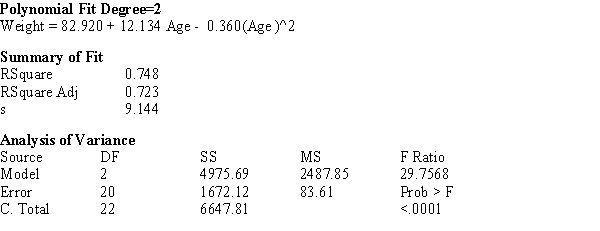Essay
Polar bear cubs are born in the winter in dens, and they must live off the fat stores of the mother even after leaving the den for sea ice, since the availability of their prey is unpredictable. Therefore, maternal weight is an important factor in successful reproduction of polar bears. In a recent spring, 261 adult females with 492 cubs were captured as they left their dens, and the mothers' weight and ages were determined by "counting annuli in the cementum of an extracted vestigial premolar tooth." (We are NOT making this up!) A quadratic fit of the maternal weight in kilograms to age in years resulted in the regression analysis below. 

a) On average, about how far off are the weights of the maternal bears? That is, what is a typical difference between the actual weights and the weights predicted by the quadratic model?
b) If the maternal weight is an important factor as discussed above, what age of the female would seem to be the best for reproduction success? In a few sentences, justify your answer by appealing to the information provided above.
Correct Answer:

Verified
a) s = 9.14 kg
b) T...View Answer
Unlock this answer now
Get Access to more Verified Answers free of charge
Correct Answer:
Verified
b) T...
View Answer
Unlock this answer now
Get Access to more Verified Answers free of charge
Q27: As early as 3 years of age,
Q28: The least squares line passes through the
Q29: A transformation, or reexpression, of a variable
Q30: If a scatter plot exhibits a strong
Q31: Pearson's correlation coefficient, r, does not depend
Q32: When children and adolescents are discharged from
Q33: The standard deviation about the least squares
Q35: The slopes of the least squares lines
Q36: An independent, or explanatory, variable is the
Q37: The data below were gathered on a